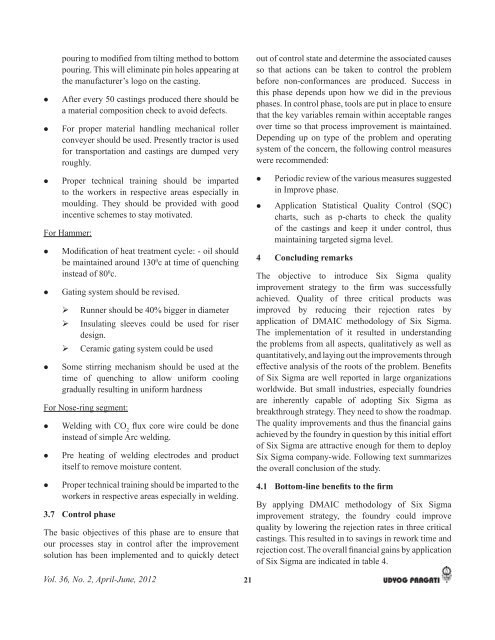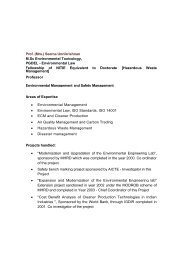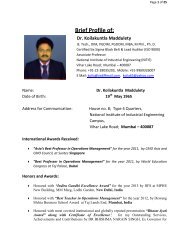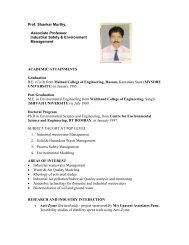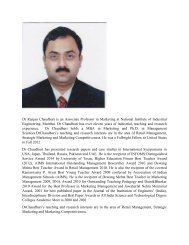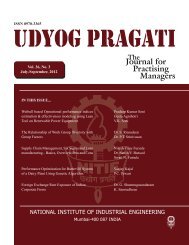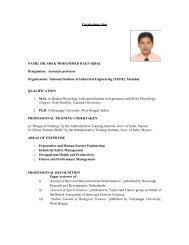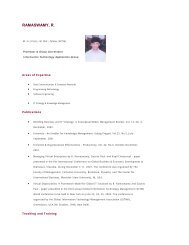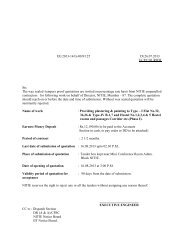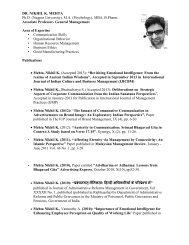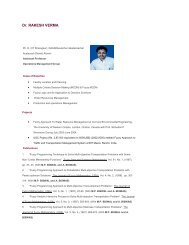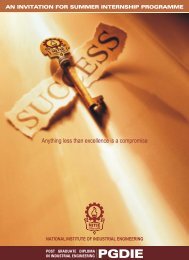Apr-Jun.12 - the Nitie
Apr-Jun.12 - the Nitie
Apr-Jun.12 - the Nitie
Create successful ePaper yourself
Turn your PDF publications into a flip-book with our unique Google optimized e-Paper software.
pouring. This will eliminate pin holes appearing at<br />
<strong>the</strong> manufacturer’s logo on <strong>the</strong> casting.<br />
After every 50 castings produced <strong>the</strong>re should be<br />
a material composition check to avoid defects.<br />
For proper material handling mechanical roller<br />
conveyer should be used. Presently tractor is used<br />
for transportation and castings are dumped very<br />
roughly.<br />
Proper technical training should be imparted<br />
to <strong>the</strong> workers in respective areas especially in<br />
moulding. They should be provided with good<br />
incentive schemes to stay motivated.<br />
For Hammer:<br />
<br />
<br />
<br />
<br />
be maintained around 130 0 c at time of quenching<br />
instead of 80 0 c.<br />
Gating system should be revised.<br />
<br />
Insulating sleeves could be used for riser<br />
design.<br />
Ceramic gating system could be used<br />
Some stirring mechanism should be used at <strong>the</strong><br />
time of quenching to allow uniform cooling<br />
gradually resulting in uniform hardness<br />
For Nose-ring segment:<br />
<br />
<br />
<br />
Welding with CO 2<br />
<br />
instead of simple Arc welding.<br />
Pre heating of welding electrodes and product<br />
itself to remove moisture content.<br />
Proper technical training should be imparted to <strong>the</strong><br />
workers in respective areas especially in welding.<br />
3.7 Control phase<br />
The basic objectives of this phase are to ensure that<br />
our processes stay in control after <strong>the</strong> improvement<br />
solution has been implemented and to quickly detect<br />
out of control state and determine <strong>the</strong> associated causes<br />
so that actions can be taken to control <strong>the</strong> problem<br />
before non-conformances are produced. Success in<br />
this phase depends upon how we did in <strong>the</strong> previous<br />
phases. In control phase, tools are put in place to ensure<br />
that <strong>the</strong> key variables remain within acceptable ranges<br />
over time so that process improvement is maintained.<br />
Depending up on type of <strong>the</strong> problem and operating<br />
system of <strong>the</strong> concern, <strong>the</strong> following control measures<br />
were recommended:<br />
<br />
<br />
Periodic review of <strong>the</strong> various measures suggested<br />
in Improve phase.<br />
Application Statistical Quality Control (SQC)<br />
charts, such as p-charts to check <strong>the</strong> quality<br />
of <strong>the</strong> castings and keep it under control, thus<br />
maintaining targeted sigma level.<br />
4 Concluding remarks<br />
The objective to introduce Six Sigma quality<br />
<br />
achieved. Quality of three critical products was<br />
improved by reducing <strong>the</strong>ir rejection rates by<br />
application of DMAIC methodology of Six Sigma.<br />
The implementation of it resulted in understanding<br />
<strong>the</strong> problems from all aspects, qualitatively as well as<br />
quantitatively, and laying out <strong>the</strong> improvements through<br />
<br />
of Six Sigma are well reported in large organizations<br />
worldwide. But small industries, especially foundries<br />
are inherently capable of adopting Six Sigma as<br />
breakthrough strategy. They need to show <strong>the</strong> roadmap.<br />
<br />
achieved by <strong>the</strong> foundry in question by this initial effort<br />
of Six Sigma are attractive enough for <strong>the</strong>m to deploy<br />
Six Sigma company-wide. Following text summarizes<br />
<strong>the</strong> overall conclusion of <strong>the</strong> study.<br />
<br />
By applying DMAIC methodology of Six Sigma<br />
improvement strategy, <strong>the</strong> foundry could improve<br />
quality by lowering <strong>the</strong> rejection rates in three critical<br />
castings. This resulted in to savings in rework time and<br />
<br />
of Six Sigma are indicated in table 4.<br />
Vol. 36, No. 2, <strong>Apr</strong>il-June, 2012<br />
21


